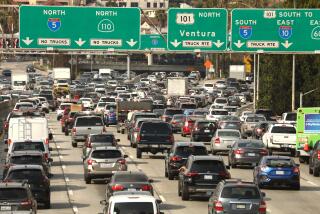Sharing Rides Is Cheapest Way to Go
- Share via
Dan Akst’s column hit the mark. Increasing the efficiency of the region’s transportation resources by getting more people into each car (ridership is now 1.1 persons per car) and limiting the number of vehicles to roadway capacities would go a long way toward clearing the air--and the roads--without enormous expenditures in alternative transportation systems.
Based on forecasts for the year 2010, reducing vehicle miles of travel 12% would, on average, cut smog-causing emissions from cars by 19%, increase highway speeds 27% and save the average motorist nearly 20 minutes per day.
Unfortunately, the most of the current approaches to increased vehicle occupancy (including mandatory ride-sharing administered by employers) are unlikely to make much difference, as they address less than 25% of the miles driven in the Los Angeles Basin.
A better approach, as mentioned in the article, would be to charge drivers for using scarce roadway space during peak hours. This approach, which works so well with phones, would apply to all drivers, not just particular drivers such as those who work for large employers. So that these new user fees do not add a new financial burden to travelers, they should replace other transportation taxes.
Revenues should also be used to fund alternatives to auto travel. Officials at the Air Quality Management District, the Southern California Assn. of Governments, the Air Resources Board and Caltrans need to dedicate themselves to furthering such solutions.
MICHAEL CAMERON
The writer is transportation director of the Environmental Defense Fund & Regional Institute of Southern California.
More to Read
Sign up for Essential California
The most important California stories and recommendations in your inbox every morning.
You may occasionally receive promotional content from the Los Angeles Times.










